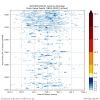The paper is behind a paywall, but this is a nice article posted today on some research dealing with North American cold and the Polar Vortex
https://t.co/cc32KL89vr?amp=1
"Evidently, the Arctic High regime is strongly sensitive to the strength of the stratospheric winds, being 7 times more likely following a weak vortex versus a strong vortex. The Arctic Low regime displays the opposite sensitivity, being more likely following a strong vortex."
"A similar but weaker relationship is found for the Pacific Trough. The Alaskan Ridge regime, however, does not display a sensitivity to the vortex strength. This result was somewhat surprising as the Alaskan Ridge regime resembles a pattern which became known as a “
polar vortex outbreak”,"
"Our results therefore suggest that the strength of the stratospheric polar vortex does not change the likelihood of the circulation pattern with the greatest potential for driving extreme cold weather in North America (in stark contrast to Europe), and that prediction of this pattern should look elsewhere – either to the tropics, or to changes in the shape of the stratospheric vortex – including wave reflection events "
CLIFF NOTES: Just because the Strat PV is "strong" doesn't mean cold outbreaks (and DEEP cold outbreaks) can't happen. This research shows there are other drivers, such as the tropics, that are responsible for the coldest regime (-EPO) for North American cold outbreaks. It does however, confirm, that high latitude blocking is much more likely to follow weak PV, which makes sense.
















